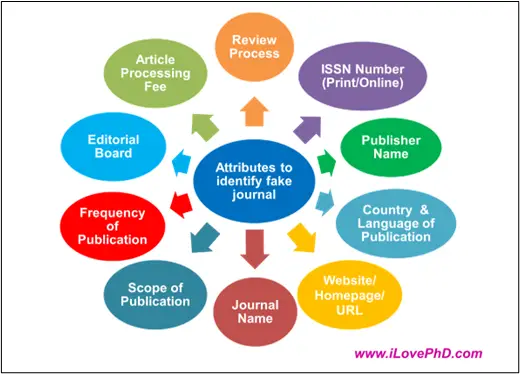A section of the research community is falling prey to Predatory journals/fake Journals which are imitations of well-established journals, and so it is a matter of serious concern. Publishers of fake/predatory journals constantly attract authors to publish articles in their journals. They charge huge amounts of money in the name of article processing fees and publish papers without any review process, in no time.
Research scholars are automatically attracted to such quick and easy publication offers and are becoming victims of such illegal practices. In the process, researchers are losing their effort, time, content, money, reputation, peace of mind, and above all credibility.
Therefore, in this article, iLovePhD listed the following guidelines to identify fake/predatory journals.
Guidelines to identify Predatory journals or Fake Journals
- The common attributes of any Journal are, Journal Name, Publisher Name, ISSN No.(print/online), Country and Language of publication, Website / Homepage / URL, Frequency of publication, Article processing fee, Scope of publication, Editorial board, and Review process.

- Scholars and researchers should double-check the websites of the journals recommended.
- The absence of an authentic URL for a Journal does not entitle them to publish papers in their fake counterparts.
- Articles published or accepted for publication in such counterfeit journals and claimed for Dissertation / Thesis / Supervisor Recognition will be summarily rejected by the Universities.
- Academic institutions / Research organizations will not be responsible for any act of scholars/researchers publishing articles in fake/predatory journals, either out of ignorance or due to oversight.
- It is important that researchers are to be vigilant at all times while submitting their articles to Journals.
- Most of the fake journals are imitations of well-established journals that existed for a while.
- The websites of fake journals appear exactly similar to the original journal. The Journal Name, ISSN No., Logos, and any other major features of an authentic journal, appear exactly the same on the website of the fake/predatory journal.
- The fake journals differ from their authentic counterparts in some / all of the following: URL of the website, geographical location of the servers, country of Journal, Editorial Board, email or contact details, Postal Address, submission-to-publication time, the peer review process, the scope of the publication.
- If you come across two Journals with the same name and ISSN No., but have different URLs, you may suspect one of them to be fake. You may send a request email to the one you feel is trustworthy, for information about the authenticity of the other suspecting URL.
- Generally, many authentic journals do not charge, while the fake ones charge hefty article processing fees. Moreover, publication in a fake journal is easy and quick, and there is no peer review process.
- The fake journals ensure that their names and websites appear at the top while browsing so that authors are attracted.
- It is also recommended that authors may send request emails to any of the trustworthy third-party websites and clarify the authenticity of a Journal. In this context, the Web of Science shall be used for establishing the authenticity of a Journal.
- Usually, fake Journals approach researchers through emails / social media inviting articles, offering fast/easy publication by charging the article processing fee.
We hope this article would help our research community to identify fake, predatory, and bogus journals.
Also Read: How To Identify Fake Journals?


